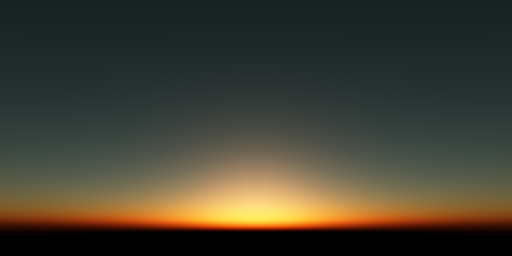https://github.com/wwwtyro/glsl-atmosphere
Renders sky colors with Rayleigh and Mie scattering.
https://github.com/wwwtyro/glsl-atmosphere
Last synced: 7 months ago
JSON representation
Renders sky colors with Rayleigh and Mie scattering.
- Host: GitHub
- URL: https://github.com/wwwtyro/glsl-atmosphere
- Owner: wwwtyro
- License: unlicense
- Created: 2016-01-11T00:05:24.000Z (almost 10 years ago)
- Default Branch: master
- Last Pushed: 2020-05-20T12:41:08.000Z (over 5 years ago)
- Last Synced: 2025-05-01T22:39:57.272Z (7 months ago)
- Language: GLSL
- Size: 119 KB
- Stars: 605
- Watchers: 17
- Forks: 47
- Open Issues: 4
-
Metadata Files:
- Readme: README.md
- License: LICENSE
Awesome Lists containing this project
- AwesomeCppGameDev - glsl-atmosphere
README
# glsl-atmosphere
Renders sky colors with Rayleigh and Mie scattering.

[Demo](http://wwwtyro.github.io/glsl-atmosphere/)
## Install
```sh
npm install glsl-atmosphere
```
## Example
### Javascript
```js
var quad = Geometry(gl)
.attr('aPosition', [
-1, -1, -1,
1, -1, -1,
1, 1, -1,
-1, -1, -1,
1, 1, -1,
-1, 1, -1
]);
program.bind();
quad.bind(program);
program.uniforms.uSunPos = [0, 0.1, -1];
quad.draw();
```
### Vertex Shader
```glsl
attribute vec3 aPosition;
varying vec3 vPosition;
void main() {
gl_Position = vec4(aPosition, 1.0);
vPosition = aPosition;
}
```
### Fragment Shader
```glsl
varying vec3 vPosition;
uniform vec3 uSunPos;
#pragma glslify: atmosphere = require(glsl-atmosphere)
void main() {
vec3 color = atmosphere(
normalize(vPosition), // normalized ray direction
vec3(0,6372e3,0), // ray origin
uSunPos, // position of the sun
22.0, // intensity of the sun
6371e3, // radius of the planet in meters
6471e3, // radius of the atmosphere in meters
vec3(5.5e-6, 13.0e-6, 22.4e-6), // Rayleigh scattering coefficient
21e-6, // Mie scattering coefficient
8e3, // Rayleigh scale height
1.2e3, // Mie scale height
0.758 // Mie preferred scattering direction
);
// Apply exposure.
color = 1.0 - exp(-1.0 * color);
gl_FragColor = vec4(color, 1);
}
```
## API
```js
#pragma glslify: atmosphere = require(glsl-atmosphere)
```
#### `vec3 atmosphere(vec3 r, vec3 r0, vec3 pSun, float iSun, float rPlanet, float rAtmos, vec3 kRlh, float kMie, float shRlh, float shMie, float g)`
Returns a `vec3` representing the color of the sky along a view direction.
Takes:
* `vec3 r` normalized ray direction, typically a ray cast from the observers eye through a pixel
* `vec3 r0` ray origin in meters, typically the position of the viewer's eye
* `vec3 pSun` the position of the sun
* `float iSun` intensity of the sun
* `float rPlanet` radius of the planet in meters
* `float rAtoms` radius of the atmosphere in meters
* `vec3 kRlh` Rayleigh scattering coefficient
* `vec3 kMie` Mie scattering coefficient
* `float shRlh` Rayleigh scale height in meters
* `float shMie` Mie scale height in meters
* `float g` Mie preferred scattering direction
For an Earth-like atmosphere, see the settings in the example above.
## Credits
* [scratchapixel](https://www.scratchapixel.com/lessons/procedural-generation-virtual-worlds/simulating-sky)
* [nvidia](https://developer.nvidia.com/gpugems/GPUGems2/gpugems2_chapter16.html)
* [patapom](https://patapom.com/topics/Revision2013/Revision%202013%20-%20Real-time%20Volumetric%20Rendering%20Course%20Notes.pdf)